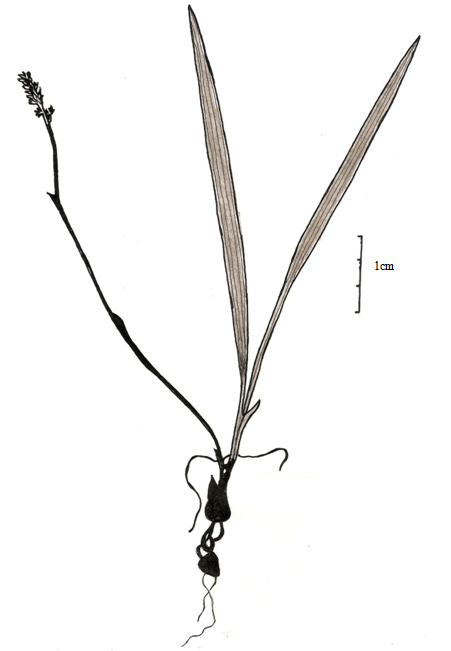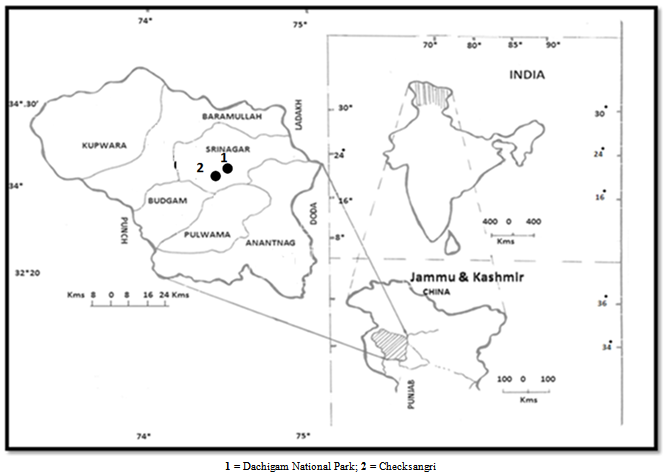-
Paper Information
- Paper Submission
-
Journal Information
- About This Journal
- Editorial Board
- Current Issue
- Archive
- Author Guidelines
- Contact Us
International Journal of Modern Botany
p-ISSN: 2166-5206 e-ISSN: 2166-5214
2013; 3(1): 10-14
doi:10.5923/j.ijmb.20130301.03
Oreorchis micrantha Lindley: A New Record to Kashmir Valley
Gowhar A. Shapoo , Zahoor A. Kaloo , Seema Singh , Aijaz Hassan Ganie , Burhan M. Paddar , Samar Amin, Tabinda A Moon
Plant Tissue Culture Research Laboratory Department of Botany University of Kashmir Srinagar, 190006, Srinagar
Correspondence to: Gowhar A. Shapoo , Plant Tissue Culture Research Laboratory Department of Botany University of Kashmir Srinagar, 190006, Srinagar.
| Email: |  |
Copyright © 2012 Scientific & Academic Publishing. All Rights Reserved.
Oreorchis micrantha Lindley (Orchidaceae) is recorded for the first time from Kashmir valley-India. A brief diagnostic taxonomic description with an illustration, photographs and distribution map is provided.
Keywords: First Record, Taxonomic Description, Distribution, Kashmir Valley
Cite this paper: Gowhar A. Shapoo , Zahoor A. Kaloo , Seema Singh , Aijaz Hassan Ganie , Burhan M. Paddar , Samar Amin, Tabinda A Moon , Oreorchis micrantha Lindley: A New Record to Kashmir Valley, International Journal of Modern Botany, Vol. 3 No. 1, 2013, pp. 10-14. doi: 10.5923/j.ijmb.20130301.03.
Article Outline
1. Introduction
- Orchidaceae is a monocot family of herbaceous perennials that include terrestrial, saprophytic, lithophytic and epiphytic species[1]. It is one of the largest family among monocots and the second largest family among angiosperms with an estimate of about 800 genera and 25, 000 species distributed worldwide[2]. Orchids are widely distributed in all continents except Antarctica, but reach their maximum diversity in the humid tropical regions[3]. In India, the family is represented ca. 184 genera with 1331 species[4], of these 400 species are endemics[5]. The genus Oreorchis constitute about 16 species[6]. The genus is characterized by terrestrial herbs with pseudo-bulbs and fibrous roots. Leaves arising from apex of pseudo-bulb, linear to oblong-lanceolate, tapering into petiole like stalk at base, often with 1or 2 membranous sheaths at base. Inflorescence arising from an intermediate node of pseudo-bulb, erect with several tubular sheaths, racemose. Flower small to medium-sized, sepals and petals free. Lip 3-lobed, entire, clawed at base without a spur.
2. Objective
- Kashmir Himalaya harbours a rich repository of Orchids. While carrying out the field surveys and collection of different Orchid species we come across an Orchid species unknown from this region. Therefore, it was thought worthwhile to undertake detailed taxonomic analysis of this species. As the species is endemic to Himalaya and reported to be threatened by various authors, the first record of this species from Kashmir valley will provide clues regarding the conservation of this species to the policy makers.
3. Materials and Methods
- The valley of Kashmir is situated in northern fringe of the Indian sub-continent between 33o22’ and 34o50’ N latitudes and 73o55 ’and 73o33’ E longitudes covering an area of about 16,000 sq. While carrying out Botanical forays in Kashmir valley a blooming orchid species was collected from 2 different localities, the plant specimens were collected and processed and herbarium specimens were prepared and deposited at Kashmir University Herbarium (KASH). After critical examination the species was identified as Oreorchis micrantha. The identification of the species was authenticated by Dr. Jagdeep Verma, Department of Botany, Shoolini Institute of Life Sciences and Business Management, Solan-173212, Detailed perusal of the relevant taxonomic literature[7,8,9,10,11]revealed that this species has not so far been reported from Kashmir valley[12]. The present report represents the first record of Oreorchis micrantha from Kashmir valley- India. A detail taxonomic description, an illustration and distribution map is given here to facilitate its easy identification in the field.
4. Results
4.1. Taxonomic Description
- Oreorchis micrantha Lindley in Journ. Linn.Soc.iii, 27.The species is pseudobulbous, sympodial, leafy herb up to 25 cm tall; pseudobulb about 2cm long, ovoid-conical, several noded; leaves two rarely three , linear-lanceolate, 15-30 X 0.6-1 cm, prominently 2-5 nerved, gradually tapering at base into an indistinct petiole like stalk; scape from the side of pseudobulb; inflorescence raceme, 5-10 cm long, few flowered ; flowers almost sessile, 1cm long, pale yellow, lip white spotted purple; sepals linear-lanceolate, acute, slightly spreading, lateral pair subfalcate, little shorter and broader than the dorsal; petals shorter than the lateral sepals, sometimes spotted purple, lip white, spotted with purple, 3-lobed, lateral lobes slender, lanceolate, falcate, thin,free and attached by a narrow base to a portion above the claw near the base, hypochile with oval to linear elevated channeled fleshy callus, bilobed with crumpled margin (Fig.1 and 2)
 | Figure 1. Oreorchis micrantha ; (A) Habit; (B) Habit;(B)Inflorescence; (C) Pseudo-bulb; (D) Flower |
 | Figure 2. Oreorchis micrantha |
4.2. Distribution
- The species is distributed in India, China, Bhutan, Tibet, Taiwan, Myanmar and Nepal. In India the species is reported from Garhwal-Uttarakhand (Dehra Dun, Tehri, Chamoli, Ramni forest, Nanda Devi National Park), Kumaun- Uttarakhand (Almora), Himachal Pradesh (Tali forest, Narkanda, Shimala) and Jammu and Kashmir (Poonch-Jammu region) and now Kashmir valley of Jammu and Kashmir (Fig 3).
 | Figure 3. Map showing collection sites |
4.3. Specimens Examined
- India, Kashmir: Srinagar, Dachigam, 19 -06- 2011, Gowhar A. Shapoo & Burhan M. Paddar 3001; Dachigam, 13 -06- 2012, Gowhar A. Shapoo 3002; Checksangri, 1- 7- 2012, Gowhar A. Shapoo 3003 (All at KASH=Kashmir University Herbarium).
4.4. Local Distribution
- In Kashmir valley the species has been collected from Dachigam National Park-Srinagar (2372m asl, 34°67.056´N, 74°01.423´E) and Cheksangri–Srinagar (3015m asl, 34°15.423´N, 74°31.125´E) (Fig 3).
5. Discussion
- Four species of the genus Oreorchis, namely O. foliosa, O. indica, O. micrantha and O. rolfei has been reported from North-West Himalaya[7,9]. The species of the genus are differentiated on the basis leaf character, flower colour, characteristics of lip, epichile and hypochile[7,9]. The present study revealed that the leaves of the taxon are solitary, flowers white to pale yellow, lip white with purple spots, not saccate at base; hypochile with ovate to linear elevated fleshy callus and hypochile bi-lobed with crumpled margins.On the basis these morphological traits the species has been identified as O. micrantha.The species is reported to be threatened, Hágsater and Dumont [15] categorize the species as endangered and Jalal (2012) categorize it as occasional. In addition to this the species has ethno medicinal uses as well- the powder of bulbs is mixed with milk and the mixture is used as aphrodisiac in Kashmir valley. Keep in view its threatened status and aphrodisiac properties of the taxa the documentation of the species is very important in terms of its conservation and local use.
6. Conclusions
- While carrying out field studies on Orchids in Kashmir valley we come across a Oreorchis species which were not recorded from this region. After detailed taxonomic analysis, this distinctive species was identified as O. micrantha, a first record from this region. The first record of this threatened species from this region of Himalaya will bring attention of policy makers toward the conservation of this species
ACKNOWLEDGMENTS
- We are highly thankful to the Head, Department of Botany, University of Kashmir, Srinagar, for providing necessary facilities. We also greatly acknowledge the kind help of Dr. Jagdeep Verma, Department of Botany, Shoolini Institute of Life Sciences and Business Management, Solan-173212, Himachal Pradesh–India and Dr. A.R. Naqshi, Department of Botany, University of Kashmir, who authenticated the identification of the plant specimen. We are also thankful to Prof. S. P. Vij, Secretary The Orchid Society of India, Department of Botany, Panjab University Chandigarh- 160014 – India for providing the relevant literature. We are also thankful to Conservator of Forests J&K, Chief wildlife warden, Regional wildlife wardens for permitting us to carry out field surveys and collections in different regions of Kashmir Himalaya.
 Abstract
Abstract Reference
Reference Full-Text PDF
Full-Text PDF Full-text HTML
Full-text HTML